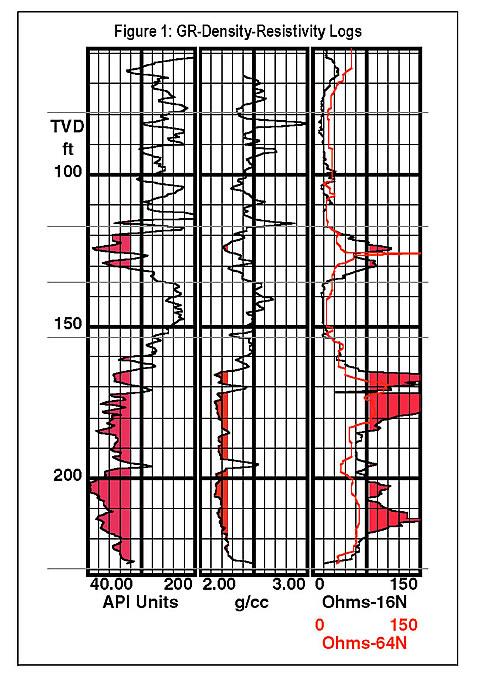Significant heavy oil reserves lie along a corridor that extends for 250 miles along the Kansas-Missouri border and covers an area of nearly 8,000 sq miles. Heavy oil (ranging from 8º to 25º API) is found throughout this trend most frequently in the Warner sandstone of the Cherokee Group of the Middle Pennsylvanian age. A previous study conducted by Wells1 in 1979 indicated that heavy oil reserves in Missouri alone total nearly 2 billion barrels. (Note: DOE defines heavy oil as 10º to 20º API, and gives the most recent estimate for heavy oil-in-place for Missouri as 100,000,000 bbl with an additional 100,000,000 in Kansas and 500,000,000 bbl in Oklahoma from the Forest City and Cherokee Basin region.)2
Historical attempts to recover Missouri’s heavy oil have focused on steamflooding, intermittent steam injection, and a reverse fireflood. While intermittent steam injection has proven technically successful, the operation was not sustainable at low oil prices. Without any enhanced recovery techniques, wells in western Missouri will yield less than 1 barrel of oil per day.
Project Results
The project has been undertaken to demonstrate an economically viable and sustainable method of producing shallow heavy oil reserves in Missouri using a combination of microbial enhanced oil recovery (MEOR) treatments and horizontal fracturing in vertical wells. The project includes a surface geochemistry survey. Electrical resistivity tomography (ERT) has also been applied to monitor the reservoir volume affected by the microbial treatments. Results from the survey were used with 2-D resistivity profiles to determine the most favorable drilling locations.
Benefits
The extremely shallow heavy oil deposits in southwest Missouri is at an average depth of 160 ft. While Missouri is not known as a major oil-producing state, experts have estimated that it has over two billion barrels of recoverable oil. Use of a combination of methods including hydraulic fracturing, microbial-enhanced oil recovery (MEOR), electrical resistivity tomography (ERT) and surface geochemistry will assist independent operators in Missouri to recover significant quantities of heavy oil.
Project Summary
Project researchers collected 110 soil samples in a grid pattern from leaseholds in Vernon County, MO. Another 65 soil samples were collected around previously drilled wells. Geochemical analysis was used to identify productive and non-productive areas of the Warner sand. The samples were analyzed for 11 C1-C6 hydrocarbon components using gas chromatography and synchronous scanned fluorescence. The fluorescence data showed good contract between productive and non-productive areas.
The project team drilled five vertical wells to a depth of 220 feet in the Warner sands. The cores were collected and analyzed to design the hydraulic fracturing treatments. Fifteen latest-generation, self-leveling tiltmeters were placed in surface holes to access the deformation from the hydraulic fracture treatments.
Microbial treatments were started in all wells in late 2003. The wells have been treated monthly with 8 gallons of Para-Bac S, 4 gallons of Ben-Bac, and 8 gallons of Corroso-Bac with one barrel of flush. MEOR treatments were placed in the well-bore but were not squeezed into the formation, primarily due to limitations of the openhole wells.
Following each microbial treatment, 3-D ERT measurements were taken to determine the effects that microbes are having on the heavy oil. ERT data acquisition involves the collection of resistivity and chargeability (induced polarization, or IP) data between all three well pairs: well Nos. 2 to 3, 2 to 4, and 3 to 4. The data show strong evidence for electrical changes in the oil-bearing formation since the start of the microbial treatments. Generally, there has been an increase in resistivity of the Warner sand since initiation of the microbial treatment. This may result from the bacterial mobilization of oil from the mineral surface into the pore space.
ERT wells have not been pumped as planned, due to difficulties in removing the ERT arrays. Pumping results on the hydraulically stimulated wells have had strong oil shows with gas. Microbial treatments continued into the summer of 2004, and at least one ERT well was scheduled to be pumped to determine the production results of this project.






